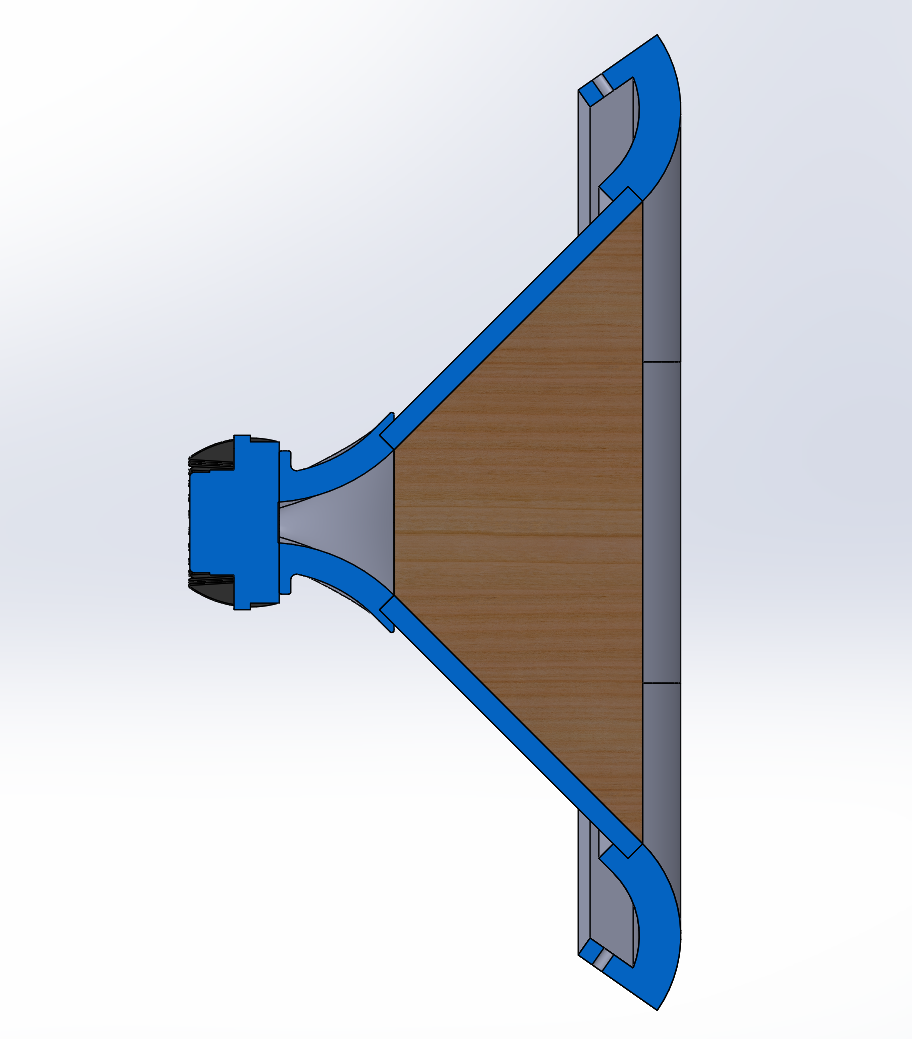

In this blog post I test a new horn design that I've come up with. The idea is to provide a large format oblate spheroidal horn flare which is characterized as a conical horn with a smooth throat transition. This blog post also looks at the affect of large mouth flares in order to reduce reflections off the horn mouth.
The 3D CAD files and plans can be purchased here.




Design Goals
- Easy to construct for DIY enthusiasts
- Horn throat can be 3D printed
- Horn petals are easy to construct especially compared to the Sabourin horn which consists of three flare segments. This Oblate Spheroidal (OS) consists of a single horn flare segment.
- The horn mouth flares are optional (see test data to compare with and without mouth flare pieces)
- Suitable for home theater, home hifi, and PA applications
- Provides constant directivity for use in PA
- Attempts low coloration sound
- Most Constant Directivity (CD) horns have high coloration due to abrupt physical horn flare geometry
- Provide reasonable falling response
- Most CD horns have significant falling response requiring EQ to flatten. This raises distortion in the treble region since the driver is having to work hardware to reproduce those frequencies compared to an exponential horn flare.
-










Test Data
Below is the raw frequency response with the RCF ND940 compression driver using a 20cm mic distance. The response below is gated.

By moving the mic away to 1m, removing the gate, and applying some smoothing, we get a better sense on what happens near the cutoff frequency of the horn.

Below is the response at 0,15,30, & 45 degrees off-axis.

Removing Mouth Flares and Testing Again




To highlight this I've overlaid the response (blue) with the mouth flares installed. 
For context and comparison I've pulled up some older test data using the same compression driver. Below is the response of the Yuichi A290 with the RCF ND940/950. Please note that the ND940 is simply the ND950 with the conical adapter removed. So we are using the same driver between tests. 
For additional comparison data I've shown the ES-290 biradial with the same RCF compression driver. 
Power & DI
For those interested I've compiled the same data into a Power & DI. These results are with the horn flares removed. This data was prepared using VituixCAD. You can click on the images below to enlarge.
Horn No.2710 with RCF ND940
Power & DI Comparison
For interest's sake, I've shown the ES-450 Biradial with the TAD TD-4003 compression driver. Please note this is the raw response (no equalization).

Below is the Yuichi A290 with the smooth throat adapter No.2322 using the SB Audience 65CDN-T.

General Conclusions
I listened to the horn in mono with EQ applied in the 800Hz region to flatten the response. The horn sounded balanced in terms of midrange and treble.
Below is a ranking for my subjective impressions on the sound quality...
Soundstage Depth --- 7/10
Soundstage Width --- 8/10
Smoothness --- 7/10
Coherence between midrange and treble --- 9/10
Vocal Clarity Male --- 7/10
Vocal Clarity Female --- 7/10
Accurate Musical Instrument timbre --- 7/10
Sense of Dynamic Range: --- 9/10
While the horn sounded dynamic, intelligible, and coherent, it lacked the last little bit of clarity I've come to expect. This limitation reduced overall soundstage depth and smoothness, having some mild horn coloration. As a result the 2710 horn is perfectly suitable for PA applications or for home theater applications where dynamics and intelligibly are of primary concern. I would not use the 2710 horn in two channel music applications.
The 3D CAD files and plans can be purchased here.






